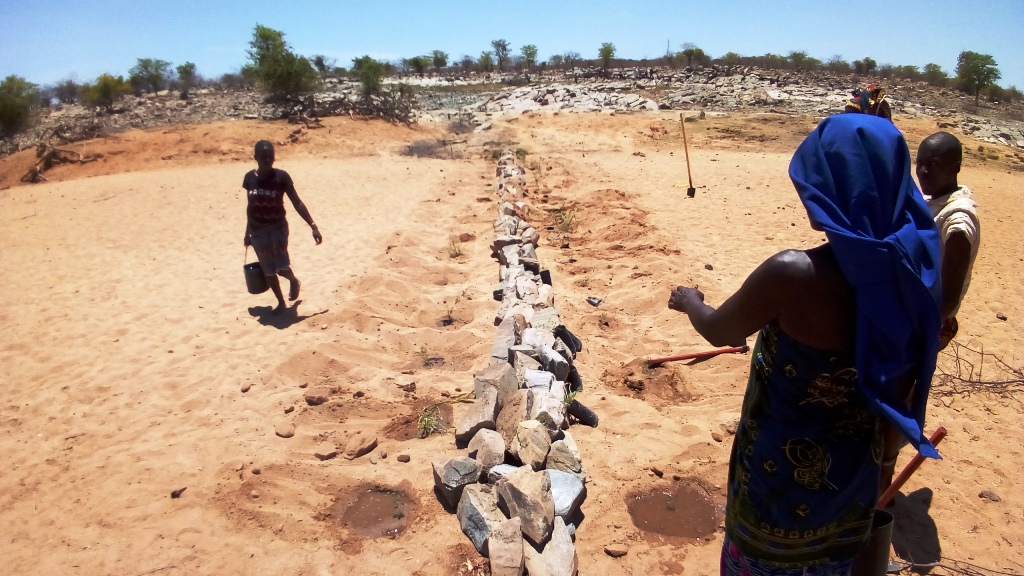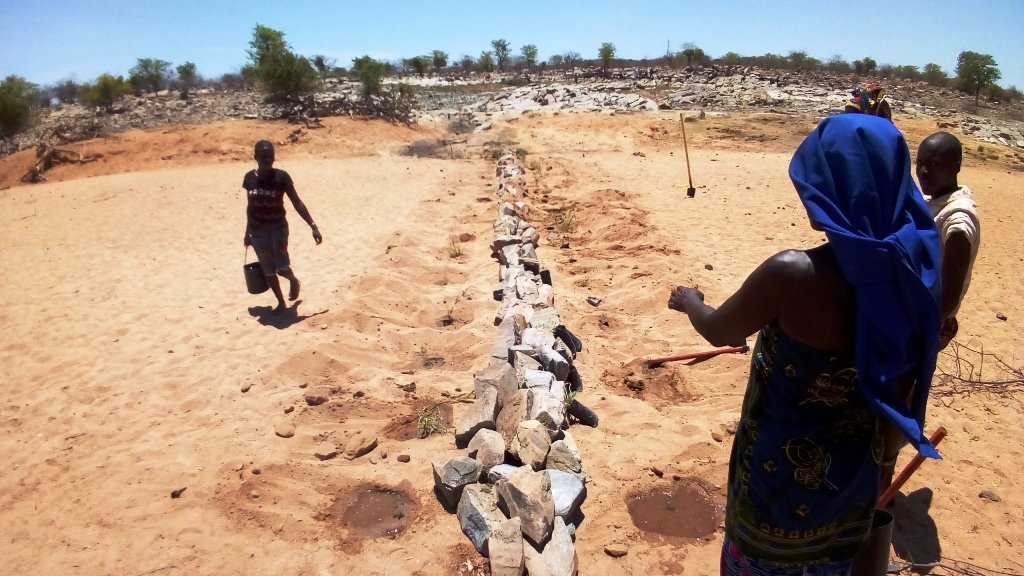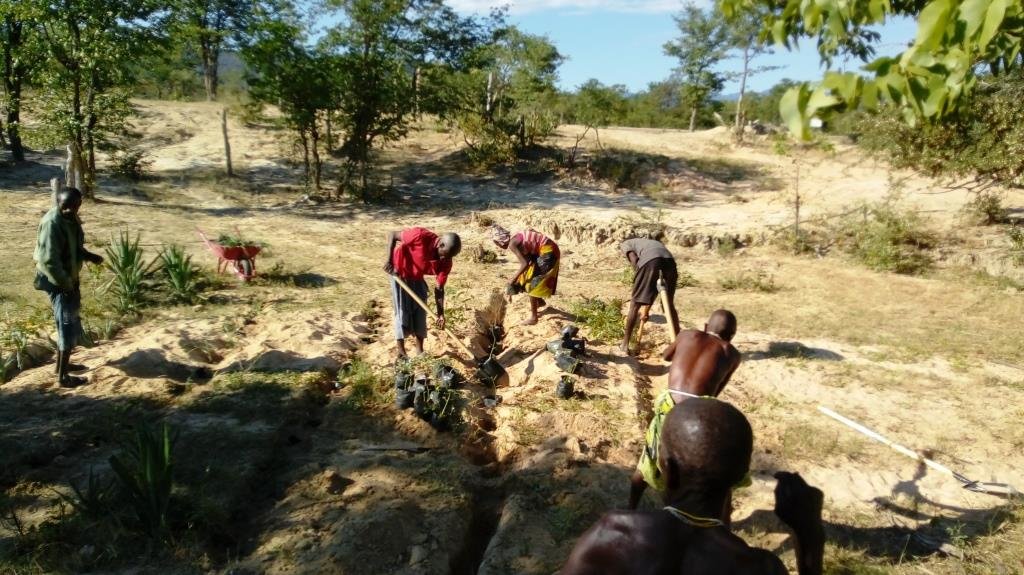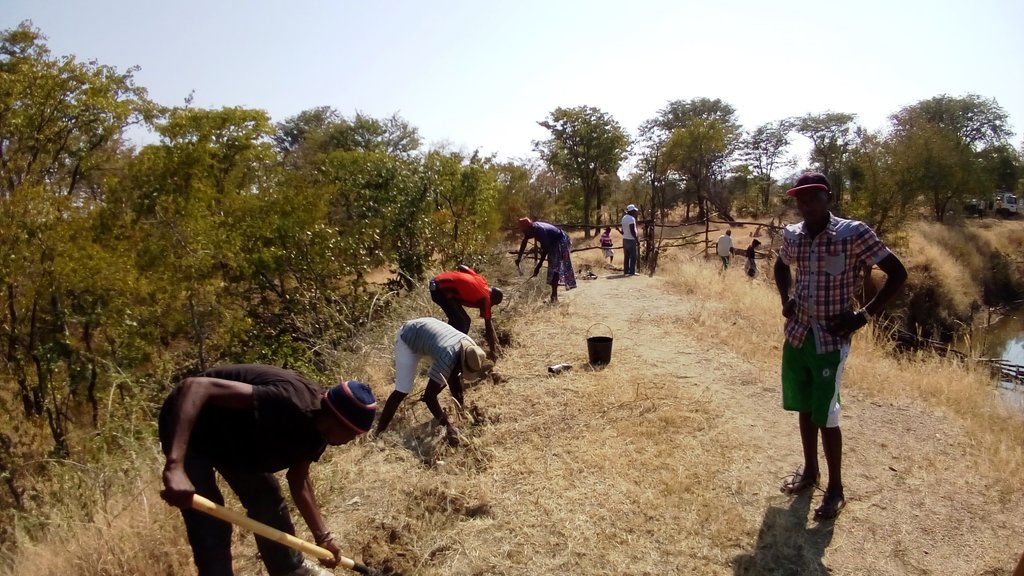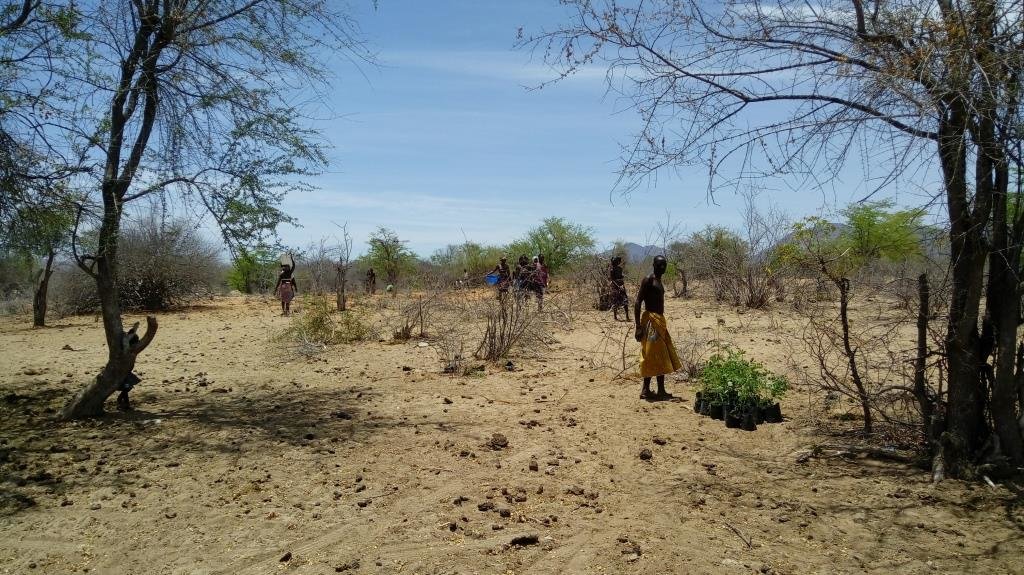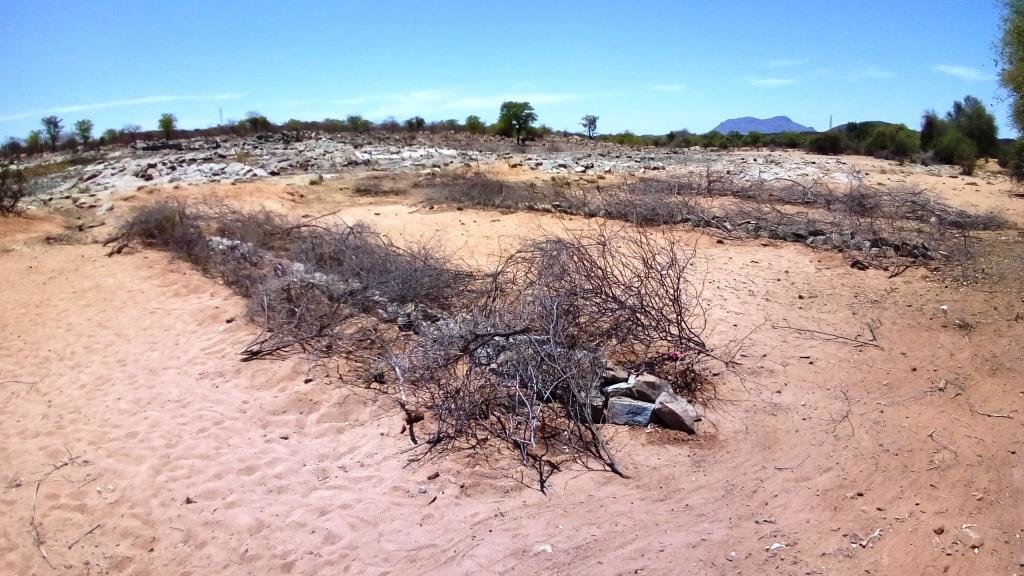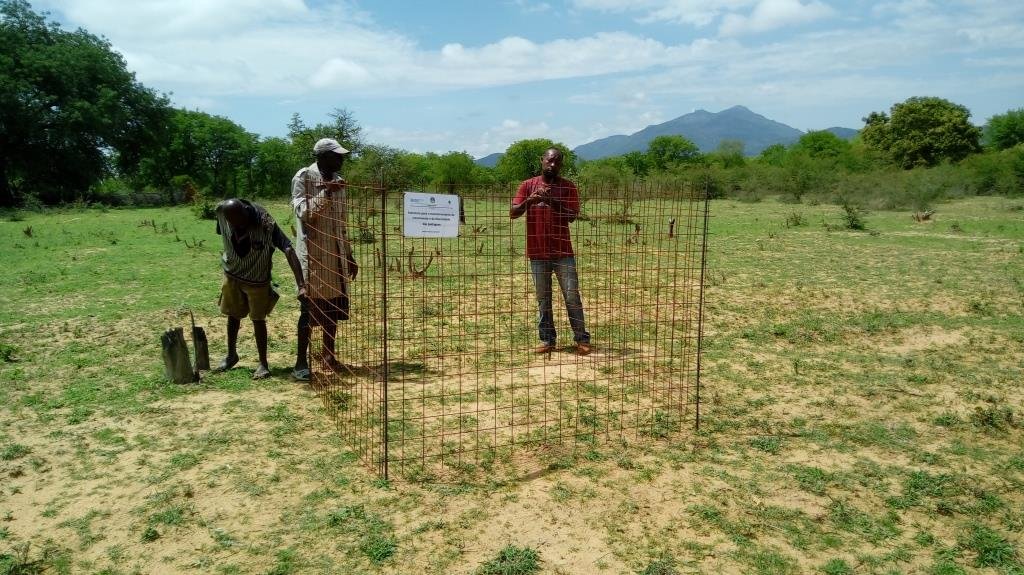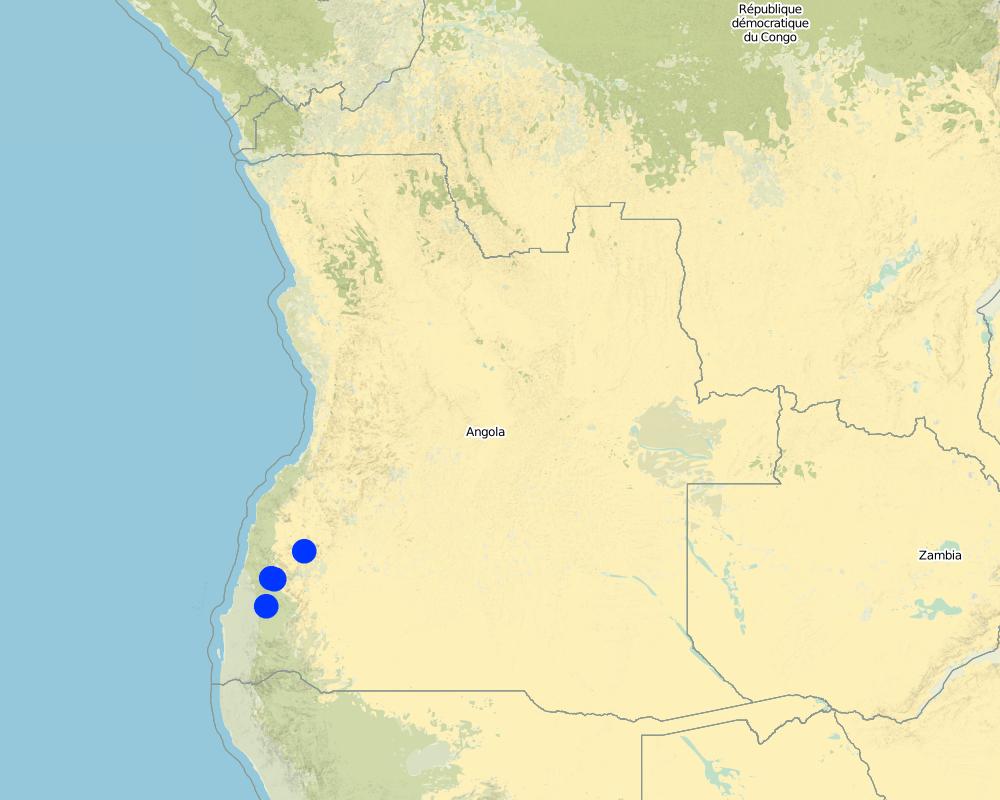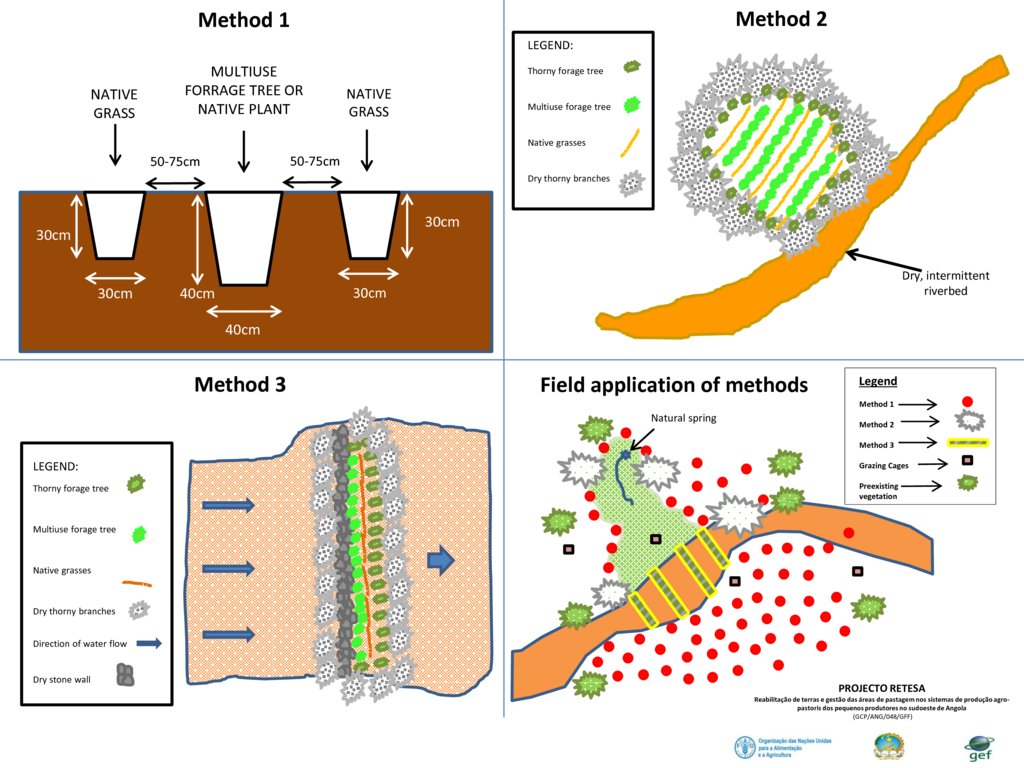Community supported pasture and rangeland rehabilitation works [Angola]
- Criação:
- Atualização:
- Compilador/a: Nicholas Euan Sharpe
- Editor: Txaran Basterrechea
- Revisor: Rima Mekdaschi Studer
technologies_3141 - Angola
- Resumo completo em PDF
- Resumo completo em PDF para impressão
- Resumo completo no navegador
- Resumo completo (sem formatação)
- Community supported pasture and rangeland rehabilitation works: 31 de Janeiro de 2018 (inactive)
- Community supported pasture and rangeland rehabilitation works: 16 de Fevereiro de 2018 (inactive)
- Community supported pasture and rangeland rehabilitation works: 6 de Março de 2019 (inactive)
- Community supported pasture and rangeland rehabilitation works: 2 de Novembro de 2021 (public)
Veja as seções
Expandir tudo Recolher tudo1. Informação geral
1.2 Detalhes do contato das pessoas capacitadas e instituições envolvidas na avaliação e documentação da tecnologia
Especialista em GST:
Nome do projeto que facilitou a documentação/avaliação da Tecnologia (se relevante)
Reabilitação de terras e gestão das áreas de pastagem nos sistemas de produção agro-pastoris dos pequenos produtores no sudoeste de Angola (RETESA)Nome da(s) instituição(ões) que facilitou(ram) a documentação/ avaliação da Tecnologia (se relevante)
FAO Angola (FAO Angola) - Angola1.3 Condições em relação ao uso da informação documentada através de WOCAT
Quando os dados foram compilados (no campo)?
15/05/2017
O/a compilador/a e a(s) pessoa(s) capacitada(s) aceitam as condições relativas ao uso de dados documentados através da WOCAT:
Sim
1.4 Declaração de sustentabilidade da tecnologia descrita
A tecnologia descrita aqui é problemática em relação a degradação da terra de forma que não pode ser declarada uma tecnologia de gestão sustentável de terra?
Não
2. Descrição da tecnologia de GST
2.1 Descrição curta da tecnologia
Definição da tecnologia:
The technology was developed and used to select key pasture and fodder species and reintroduce them into strategic areas through stakeholder participation. The technology was also supported by communal management plans were created to address root causes of land degradation.
2.2 Descrição detalhada da tecnologia
Descrição:
The technology was developed and implemented through the RETESA Project “Land rehabilitation and rangelands management in smallholders agro-pastoral production systems in south western Angola”, which is a project owned and implemented by the Ministry of Environment of the Government of Angola with technical and methodological assistance from The Food and Agriculture Organization of the United Nations (FAO) and financed by the Global Environmental Found (GEF).
Improper grazing regimes and animal management on part of pastoral communities in SW Angola have led to degradation of rangeland and pastoral resources, with perennial grassland species and shrubs having been effectively eliminated from lowland grazing areas. The pastoral communities of the area know their environment extremely well and are aware of the land degradation happening around them. They identified crucial areas for the rehabilitation works, selecting mostly areas around water points that were used both by local and transhumant herders. Through these works, the locals sought to increase ground cover to reduce sediment loads entering waterways (erosion control), provide shade for livestock, increase forage production and introduce legumes and multiuse forage trees in areas of high animal traffic. A total of 4 areas in the Bibala and Virei Municipalities were identified for the activities.
The communities were heavily involved in the selection and propagation of plant species for the rehabilitation works. The project field staff also ran participatory, field palatability trials with them to confirm the plants selected met their expectations and to enhance their understanding of livestock nutrition and how it related to animal health. Once the species were chosen, seed was collected by the communities and the Project Technicians and was multiplied in 32 Agro-Pastoral Field School Nurseries and 2 Government funded Veterinary Research Stations. A total of 15 species were identified, with Eragrostis superba, Urochloa mosambicensis, Acacia nilotica, Faidherbia albida, Leucaena leucocephala and Moringa oleifera being the most valued by the communities as forage and multiuse species. Trees and shrubs were germinated from seed with success. As their seeds failed to germinate by standard methods, native grass species were multiplied by root divisions of plants collected in cultivated fields so as not to remove any from natural areas. Early field trials ruled out direct seeding methods.
As the majority of areas selected for the rehabilitation works were focused around water points and waterways, the soils were generally alluvial, sandy loams. Precipitation is highest in the areas to the north, ranging from 600mm in the upper areas of the Bibala Municipality to 200mm in the areas to the south in Virei. In general, the vegetation communities could be described as dry sclerophyll woodlands with Colophospermum mopane being the dominant tree species, with forest cover decreasing in height and density as one moves south toward drier areas.
Through close collaboration with the participant communities, 3 rehabilitation methods were designed and improved upon throughout the Project's duration. Method 1 was used to plant open areas within the rehabilitation zone, Method 2 was used to introduce and protect concentrated plantings of the selected species in strategic locations within the landscape and Method 3 was used to recuperate riparian vegetation and reduce sediment loads in waterways. The 3 Methods used are described in more detail in the Technical Drawing on page 3. To increase appropriation and increase the effectiveness of the rehabilitation works, land management plans and other supporting activities were also carried out.
2.3 Fotos da tecnologia
2.5 País/região/locais onde a tecnologia foi aplicada e que estão cobertos nesta avaliação
País:
Angola
Região/Estado/Província:
Province of Namibe
Especificação adicional de localização:
Municipalities of Bibala and Virei
Comentários:
There are 3 main rehabilitation areas, all within the Namibe Province in Southern Angola.
Map
×2.6 Data da implementação
Caso o ano exato seja desconhecido, indique a data aproximada:
- menos de 10 anos atrás (recentemente)
2.7 Introdução da tecnologia
Especifique como a tecnologia foi introduzida:
- através de projetos/intervenções externas
Comentários (tipos de projeto, etc.):
The proposed project: “Land rehabilitation and rangelands management in smallholders’ agropastoral production systems in southwestern Angola” (RETESA) is a joint effort by the Ministério do Ambiente (MA), Ministério da Agricultura e do Desenvolvimento Rural e das Pescas (MINANDER), Governo Provincial do Namibe, Governo Provincial do Huila, and Governo Provincial de Benguela, together with FAO and GEF. In line with the GEF-5 Land Degradation strategy, the project’s goal is to create an enhanced enabling environment in the agricultural sector and a sustained flow of agro-ecosystem services.
3. Classificação da tecnologia de GST
3.1 Principal/principais finalidade(s) da tecnologia
- Melhora a produção
- Reduz, previne, recupera a degradação do solo
- Preserva ecossistema
- Preservar/melhorar a biodiversidade
- Reduzir riscos de desastre
- Adaptar a mudanças climáticas/extremos e seus impactos
- Atenuar a mudanças climáticas e seus impactos
- Criar impacto econômico benéfico
3.2 Tipo(s) atualizado(s) de uso da terra onde a tecnologia foi aplicada

Pastagem
Pastagem extensiva:
- Seminomadismo/pastoralismo
- Transhumance movements
Principais espécies animais e produtos:
Cattle and goats.
Milk and meat.

Vias navegáveis, corpo d'água, zonas úmidas
- Linhas de drenagem, vias navegáveis
- Lagos, represas
- Natural springs
Caso o uso da terra tenha mudado devido a implementação da tecnologia, indique seu uso anterior à implementação da tecnologia:
Cropping land is increasing in the area as population rates increase and locals move towards more sedimentary livelihoods.
3.3 Mais informações sobre o uso da terra
Abastecimento de água para a terra na qual a tecnologia é aplicada:
- Precipitação natural
Número de estações de cultivo por ano:
- 1
Densidade animal (se relevante):
Official data is not available and true livestock numbers are unknown.
3.4 Grupo de GST ao qual pertence a tecnologia
- Gestão de pastoralismo e pastagem
- Solo/cobertura vegetal melhorada
3.5 Difusão da tecnologia
Especifique a difusão da tecnologia:
- Aplicado em pontos específicos/concentrado numa pequena área
Comentários:
Plantings areas are selected due to their importance and relevance to the local communities. For the most part, the plantings have been centred around key water points. In order to increase impact and scale up the process of rangeland rehabilitation and improvement, management plans are negotiated and agreed upon by the communities through the Green Negotiated Territorial Development Approach (GreeNTD) processes.
3.6 Medidas de GST contendo a tecnologia

Medidas vegetativas
- V1: cobertura de árvores/arbustos
- V2: gramíneas e plantas herbáceas perenes

Medidas de gestão
- M2: Mudança de gestão/nível de intensidade
Comentários:
The management plans created at the community and administrative level identify a number of large areas which are to serve as 'Grazing Reverses' for the dry season. Therefore, the agreements call for all livestock to abandon the area at the onset of the first rains and not return until the Pastoral Management Forum agrees to open the area for grazing. Once open, the range is available to all pastoralists, those that live in the immediate area and those moving through on their transhumance migration.
3.7 Principais tipos de degradação da terra abordados pela tecnologia

Erosão do solo pela água
- Wt: Perda do solo superficial/erosão de superfície
- Wr: erosão das margens

Degradação biológica
- Bc: redução da cobertura vegetal
- Bh: perda dos habitats
- Bq: quantidade/ declínio da biomassa
- Bs: Qualidade e composição de espécies/declínio de diversidade
- Bl: perda da vida do solo
3.8 Redução, prevenção ou recuperação da degradação do solo
Especifique o objetivo da tecnologia em relação a degradação da terra:
- Reduzir a degradação do solo
- Recuperar/reabilitar solo severamente degradado
4. Especificações técnicas, implementação de atividades, entradas e custos
4.1 Desenho técnico da tecnologia
4.2 Especificações técnicas/ explicações do desenho técnico
Plantings are typically based on 3 established methods, as seen in the exemples provided.
- Method 1 relies on placing a leguminous, multiuse tree species in the ground with two native grass species to each side of the tree. The holes are dug and a small amount of manure is placed in the bottom of the hole, adding some water to the hole if it is readily available. Then the trees and grasses are planted and well watered. Finally, a branch or two of thorny shrubs or trees are placed over the plants to protect them from grazing (where possible, attempts are made to use thorny branches that were already dead or had fallen).
- Method 2 requires the creation of an enclosed, protected area which is then planted in high densities, preferably in low-lying areas where soil moisture is available to support such high concentrations of plants. Dry, dead branches from thorny trees and shrubs were used to create the enclosures and provide protection to these plantings.
- Method 3 is based on the creation of a 'Leaky weir', which is a small stone barrier planted with a mixture of native riparian species placed horizontally to the flow of water. It is intended to slow the flow of water and allow for the recovery of riparian vegetation. The plants are also protected with dry, dead branches from thorny trees and shrubs in this method.
To increase their effectiveness, it is recommended that the 3 methods be combined within the landscape, as seen in the 4th slide 'Field application of methods'.
4.3 Informação geral em relação ao cálculo de entradas e custos
Especifique como custos e entradas foram calculados:
- Por unidade de tecnologia
Especifique a unidade:
3345 seedlings produced, delivered and planted
Especifique volume, comprimento, etc (se relevante):
3345 units
Especifique a moeda utilizada para os cálculos de custo:
- Dólares norte-americanos
Indique a média salarial da mão-de-obra contratada por dia:
6 Dollars
4.4 Atividades de implantação
| Atividade | Tipo de medida | Periodicidade | |
|---|---|---|---|
| 1. | Meetings and field visits with participant communities to identify plant species and their uses | Outras medidas | Best during growing season |
| 2. | Further meetings to decide on which species are to be multiplied and arrange seed collection | Outras medidas | Near end of growing season |
| 3. | Seed collection and transportation | Outras medidas | When seed is available (varies with species) |
| 4. | Instalation of irrigation systems | Estrutural | Most communiites need a water extraction and distribution system to create nurseries |
| 5. | Delivery of nursery supplies and instalation of shade cloth | Estrutural | Nurseries should have water access and shade |
| 6. | Planting of seeds and care for seedlings at nursery | Vegetativo | Formed part of Agro-Pastoral Farmer Field School activities |
| 7. | Identification of planting areas and timing | Outras medidas | Should be at beginning of rainy season, or when soil moisture permits |
| 8. | Organisation of materials and tools | Outras medidas | At least 1 week before the planting |
| 9. | Planting day (preparation of planting holes and transplanting of seedlings) | Vegetativo | 2 days maximum was seen to be optimal |
| 10. | Watering until the plants are established | Agronômico | Usually a maximum of 3 watering over 1 week after the plantings |
| 11. | Follow up visits to make sure management agreements are being respected and plants are not being eaten by stock until they are ready | Gestão | Plants should not be grazed for at least 6 months from planting time until they are well established |
Comentários:
The activities and costs given were those needed to produce and plant 3,345 trees and grasses in the 4 rehabilitation areas. Given that 3.345 plants were produced at a cost of $3284.75, the cost per plant produced and planted in the field is $0.98. As the inputs and materials for the 3 methods came from the same source and the methods were implemented together at the same time, no distinction of the costs for each method is avaliable, though the labour and materials are similar enough so that they one could assign the same costs for the 3.
As per the question of planting densities, they are often dependent on numerous factores but one can easily calculate the costs per hectare by knowing plant densities and deducing the costs.
4.5 Custos e entradas necessárias para a implantação
| Especifique a entrada | Unidade | Quantidade | Custos por unidade | Custos totais por entrada | % dos custos arcados pelos usuários da terra | |
|---|---|---|---|---|---|---|
| Mão-de-obra | Project Technicians/Drivers/Consultants, etc | Person-days | 30,0 | 20,0 | 600,0 | |
| Mão-de-obra | Plant identification activities and seed collection | Person-days | 10,0 | 6,0 | 60,0 | 100,0 |
| Mão-de-obra | Plant nursery creation and plant production | Person-days | 16,0 | 6,0 | 96,0 | 100,0 |
| Mão-de-obra | Participation during planting days | Person-days | 25,0 | 10,0 | 250,0 | 90,0 |
| Equipamento | Vehicle | Trips | 10,0 | 40,0 | 400,0 | |
| Equipamento | Nursery supplies (including water system which also supplies water to Farmer Field School) | Materials | 1,0 | 800,0 | 800,0 | 10,0 |
| Equipamento | Planting supplies (shovels, hoes, wheelbarrows, etc.) | Materials | 1,0 | 120,0 | 120,0 | |
| Equipamento | Other improvements to water point (fencing, cement blocks, cement, hoses, etc.) | Materials | 1,0 | 250,0 | 250,0 | |
| Equipamento | Maps (traced onto paper from projected images for management purposes) | Materials | 1,0 | 10,0 | 10,0 | |
| Equipamento | Food and Refreshments | Per person | 25,0 | 2,5 | 62,5 | |
| Fertilizantes e biocidas | Manure (50 grams per sack, 12.500 sacks) | Kilos | 625,0 | 0,25 | 156,25 | 100,0 |
| Material de construção | Shade-cloth | m2 | 320,0 | 1,5 | 480,0 | |
| Custos totais para a implantação da tecnologia | 3284,75 | |||||
Se o usuário da terra arca com menos que 100% dos custos, indique quem cobre os custos remanescentes:
Remaining costs were provided by the RETESA Project.
Comentários:
Production depends on the ability of the pastoral communities to produce viable plants. If they are unable to do so, then plants can be bought from Government funded nurseries, though costs per plant will most rise though it can substitute the need for having to purchase a water supply system. The total shown here reflects a percentage (16%) of the costs of installing a water system that supplied water to the whole of the Agro-Pastoral Farmer Field School. These systems usually included a 10,000 litre water tank, a gasoline water pump, extraction pipe and parts, 100 to 200 mts of 1.5" hoses and parts and 3 kms of drip irrigation hose.
4.6 Atividades recorrentes/manutenção
| Atividade | Tipo de medida | Periodicidade/frequência | |
|---|---|---|---|
| 1. | Meetings to ensure management agreements are being respected. | Gestão | Once every 3 to 6 months, especially before and after rainy season. |
| 2. | Repairs and replacement of nursery supplies. | Estrutural | Once a year. |
| 3. | Replanting of dead seedlings | Vegetativo | Just before and during rainy season. |
4.7 Custos e entradas necessárias pata a manutenção/atividades recorrentes (por ano)
| Especifique a entrada | Unidade | Quantidade | Custos por unidade | Custos totais por entrada | % dos custos arcados pelos usuários da terra | |
|---|---|---|---|---|---|---|
| Mão-de-obra | Visits to sites and tour of planting areas. | Person-days | 4,0 | 20,0 | 80,0 | 50,0 |
| Mão-de-obra | Driver. | Person-days | 1,0 | 20,0 | 20,0 | |
| Mão-de-obra | Replanting of dead seedlings | Person-days | 2,0 | 6,0 | 12,0 | 100,0 |
| Mão-de-obra | Watering | Person-days | 14,0 | 6,0 | 84,0 | 100,0 |
| Equipamento | Vehicle | Trips | 1,0 | 40,0 | 40,0 | |
| Equipamento | Watering cans and buckets | Materials | 4,0 | 5,0 | 20,0 | |
| Custos totais para a manutenção da tecnologia | 256,0 | |||||
Se o usuário da terra arca com menos que 100% dos custos, indique quem cobre os custos remanescentes:
The RETESA Project provided an important part of both material and technical support to the communities, though the communities also contributed substantially.
4.8 Fatores mais importantes que afetam os custos
Descreva os fatores mais determinantes que afetam os custos:
The activities and costs given were those needed to produce and plant 3,345 trees and grasses in the 4 rehabilitation areas. Given that 3.345 plants were produced at a cost of $3284.75, the cost per plant produced and planted in the field is $0.98. Seedlings avaliable through local, government nurseries were $2.00 per unit, but only exotic ornamentals were avaliable. However, it can be expected that in other contexts and locations, it would be cheaper to buy seedlings instead of training communities and creating numerous small scale nurseries, though clearly these communities will not appropriate the process as well as if they were involved from the beginning.
5. Ambiente natural e humano
5.1 Clima
Precipitação pluviométrica anual
- <250 mm
- 251-500 mm
- 501-750 mm
- 751-1.000 mm
- 1.001-1.500 mm
- 1.501-2.000 mm
- 2.001-3.000 mm
- 3.001-4.000 mm
- > 4.000 mm
Especificações/comentários sobre a pluviosidade:
In the past, the rainy season started in October or November and ran until May. However, the rains in the last few years have fallen in January to April.
Indique o nome da estação meteorológica de referência considerada:
None in the area.
Zona agroclimática
- Semiárido
5.2 Topografia
Declividade média:
- Plano (0-2%)
- Suave ondulado (3-5%)
- Ondulado (6-10%)
- Moderadamente ondulado (11-15%)
- Forte ondulado (16-30%)
- Montanhoso (31-60%)
- Escarpado (>60%)
Formas de relevo:
- Planalto/planície
- Cumes
- Encosta de serra
- Encosta de morro
- Sopés
- Fundos de vale
Zona de altitude:
- 0-100 m s.n.m.
- 101-500 m s.n.m.
- 501-1.000 m s.n.m.
- 1.001-1.500 m s.n.m.
- 1.501-2.000 m s.n.m.
- 2.001-2.500 m s.n.m.
- 2.501-3.000 m s.n.m.
- 3.001-4.000 m s.n.m.
- > 4.000 m s.n.m.
Indique se a tecnologia é aplicada especificamente em:
- Não relevante
Comentários e outras especificações sobre a topografia:
Usually the plantings are undertaken along river plains and river banks, as they are the only areas that have the necessary soil moisture to ensure survival of the seedlings.
5.3 Solos
Profundidade do solo em média:
- Muito raso (0-20 cm)
- Raso (21-50 cm)
- Moderadamente profundo (51-80 cm)
- Profundo (81-120 cm)
- Muito profundo (>120 cm)
Textura do solo (solo superficial):
- Grosso/fino (arenoso)
Textura do solo (>20 cm abaixo da superfície):
- Grosso/fino (arenoso)
Matéria orgânica do solo superficial:
- Baixo (<1%)
5.4 Disponibilidade e qualidade de água
Lençol freático:
< 5 m
Disponibilidade de água de superfície:
Precário/nenhum
Qualidade da água (não tratada):
Água potável precária (tratamento necessário)
A salinidade da água é um problema?
Sim
Especifique:
Many bores and wells cannot be used due to Salinity problems. Before planting, it is wise to make sure soil salinity is not problematic in areas identified.
Ocorre inundação da área?
Sim
Regularidade:
Esporadicamente
Comentários e outras especificações sobre a qualidade e a quantidade da água:
Water quality and quantity are major issues for the area. There are few if any reliable water sources in the area and most communities depend on wells dug in the river bottoms to supply their water.
5.5 Biodiversidade
Diversidade de espécies:
- Médio
Diversidade de habitat:
- Baixo
Comentários e outras especificações sobre biodiversidade:
The area is devoid of most wild animals due to the years of war the country experienced during the second half of the 20th century.
5.6 Características dos usuários da terra que utilizam a tecnologia
Sedentário ou nômade:
- Semi-nômade
Orientação de mercado do sistema de produção:
- Subsistência (autoabastecimento)
Rendimento não agrícola:
- 10-50% de toda renda
Nível relativo de riqueza:
- Muito pobre
Indivíduos ou grupos:
- Indivíduo/unidade familiar
Nível de mecanização:
- Trabalho manual
Gênero:
- Mulheres
- Homens
Idade dos usuários da terra:
- Jovens
- meia-idade
Indique outras características relevantes dos usuários da terra:
The communities are still traditional though are currently being influenced by the globalisation process.
5.7 Média da área de terra própria ou arrendada por usuários da terra que utilizam a tecnologia
- < 0,5 ha
- 0,5-1 ha
- 1-2 ha
- 2-5 ha
- 5-15 ha
- 15-50 ha
- 50-100 ha
- 100-500 ha
- 500-1.000 ha
- 1.000-10.000 ha
- > 10.000 ha
É considerado pequena, média ou grande escala (referente ao contexto local)?
- Grande escala
Comentários:
Agricultural plots are considered private and are usually between 1 to 2 hectares, though grazing land, which makes up the majority of the area, is still commonly owned and coveres vast areas.
5.8 Propriedade de terra, direitos de uso da terra e de uso da água
Propriedade da terra:
- Comunitário/rural
Direitos do uso da terra:
- Acesso livre (não organizado)
Direitos do uso da água:
- Acesso livre (não organizado)
5.9 Acesso a serviços e infraestrutura
Saúde:
- Pobre
- Moderado
- Bom
Educação:
- Pobre
- Moderado
- Bom
Assistência técnica:
- Pobre
- Moderado
- Bom
Emprego (p. ex. não agrícola):
- Pobre
- Moderado
- Bom
Mercados:
- Pobre
- Moderado
- Bom
Energia:
- Pobre
- Moderado
- Bom
Vias e transporte:
- Pobre
- Moderado
- Bom
Água potável e saneamento:
- Pobre
- Moderado
- Bom
Serviços financeiros:
- Pobre
- Moderado
- Bom
6. Impactos e declarações finais
6.1 Impactos no local mostrados pela tecnologia
Impactos socioeconômicos
Produção
Produção de forragens
Quantidade anterior à GST:
Low rangeland production
Quantidade posterior à GST:
Slight improvement
Comentários/especificar:
Difficult to measure. Rehabilitation works and the management plans for the rangeland areas have led to some improvement though the droughts affecting the area during the interventions significantly affected rangeland fodder production.
Qualidade da forragem
Quantidade anterior à GST:
No crop residues or fodder plantings used
Quantidade posterior à GST:
Crop residues and fodder plantings incorporated in cropping areas
Comentários/especificar:
The process allowed Project Technicians to educate communities on the use of crop residues as fodder and the planting of multiuse trees within cropping areas to provide green fodder in the dry season. The reintroduction of drought tolerante, quality native grasses should also lead an increase in fodder production over the coming year.
Produção animal
Quantidade anterior à GST:
No planning for dry season grazing, apart from transhumance movements
Quantidade posterior à GST:
Crop residues and other cultivated forages produced for those animals that stay
Comentários/especificar:
The transhumance movements of livestock are still seen as the most adequate solution to changes in natural rangeland production though most families leave behind some animals with the main family unit. These animals are now receiving the quality feed they need to remain productive and healthy.
Gestão de terra
Quantidade anterior à GST:
No management plans in place for commonly managed natural resources
Quantidade posterior à GST:
Participatory land management plans have been negociated and agreed
Comentários/especificar:
Simplied land management plans based on traditional livestock movements and cropping seasons have been negotiated and agreed upon by local stakeholders and municipal Administrators.
Disponibilidade e qualidade de água
Qualidade da água potável
Quantidade anterior à GST:
Livestock and communities drink from same water
Quantidade posterior à GST:
Separate water drinking points for livestock and community
Comentários/especificar:
Unrestricted access of livestock to community domestic water points led to waterborne diseases and poor water quality. Separating livestock and domestic use has improved community health.
Disponibilidade de água para criação de animais
Comentários/especificar:
In addition to restricting livestock access to main water bodies, new drinking troughs have been built with community support.
Qualidade da água para criação de animais
Comentários/especificar:
By separating livestock drinking points and domestic water points, waterborne illnesses have been reduced. In at least one area a water tank and new drinking trough have been built with community support.
Impactos socioculturais
Conhecimento de GST/ degradação da terra
Quantidade anterior à GST:
No education or training on land degradation
Quantidade posterior à GST:
Education and training on land degradation issues and rehabilitation methods
Comentários/especificar:
The majority of communities that have gone through the process now understand how improper land management leads to land degradation and steps they can take to reduce it.
Impactos ecológicos
Ciclo hídrico/escoamento
Quantidade de água
Comentários/especificar:
Improved ground cover and the return of riparian vegetation would increase infiltration rates and decrease evapotranspiration rates and restore the small water cycle. But this is also a long term process.
Qualidade de água
Quantidade anterior à GST:
Low
Quantidade posterior à GST:
Low in short term, improved in long term
Comentários/especificar:
Revegetation of river plains and river banks should led to improved water quality though it will be a long term effect if the rehabilitation areas are respected.
Escoamento superficial
Quantidade anterior à GST:
No method to deal with the high surface runoff rates in the area
Quantidade posterior à GST:
A method has been devised for reducing surface runoff rates.
Comentários/especificar:
The 'Leaky weir' method (Rehabilitation method 3) has shown promise over the duration of the Project and could be applied at other landscape levels to reduce surface runoff.
Solo
Cobertura do solo
Comentários/especificar:
The reintroduction of native grasses in the area should lead to improved ground cover ratios.
Perda de solo
Comentários/especificar:
The reintroduction of native grasses in the area should lead to improved ground cover ratios, binding the soil and reducing erosion rates.
Ciclo e recarga de nutrientes
Comentários/especificar:
Proper livestock management also ensures that manure is properly and evenly distributed in the field.
Biodiversidade: vegetação, animais
Cobertura vegetal
Quantidade anterior à GST:
Reduced number of poor quality grass species
Quantidade posterior à GST:
Communities capacitated in plant multiplication methods
Comentários/especificar:
Apart from the rehabilitation works themselves, the local communities have been capacitated with methods to approach and deal with land degradation.
Biomassa/carbono acima do solo
Diversidade vegetal
Comentários/especificar:
The reintroduction of native and legumous plants has improved plant diversity both within rehabilitation areas and cultived lands.
Clima e redução de riscos de desastre
Impactos da seca
Microclima
Comentários/especificar:
The works around the water points over time should lead to increase in vegetative cover, shade, habitat and reduced temperatures.
6.2 Impactos externos mostrados pela tecnologia
Capacidade de tamponamento/filtragem
6.3 Exposição e sensibilidade da tecnologia às mudanças climáticas graduais e extremos/desastres relacionados ao clima (conforme o ponto de vista dos usuários da terra)
Mudança climática gradual
Mudança climática gradual
| Estação do ano | Tipo de mudança climática/extremo | Como a tecnologia lida com isso? | |
|---|---|---|---|
| Precipitação pluviométrica anual | redução/diminuição | bem | |
| Precipitação pluviométrica sazonal | primavera | redução/diminuição | bem |
6.4 Análise do custo-benefício
Como os benefícios se comparam aos custos de implantação (do ponto de vista dos usuários da terra)?
Retornos a curto prazo:
neutro/balanceado
Retornos a longo prazo:
positivo
Como os benefícios se comparam aos custos recorrentes/de manutenção(do ponto de vista dos usuários da terra)?
Retornos a curto prazo:
neutro/balanceado
Retornos a longo prazo:
positivo
6.5 Adoção da tecnologia
- casos isolados/experimental
Entre todos aqueles que adotaram a tecnologia, quantos adotaram espontaneamente, ou seja, sem receber nenhum incentivo material/pagamentos?
- 0-10%
6.6 Adaptação
A tecnologia foi recentemente modificada para adaptar-se as condições variáveis?
Não
6.7 Pontos fortes/vantagens/oportunidades da tecnologia
| Pontos fortes/vantagens/oportunidades na visão do usuário da terra |
|---|
| Communities learn about plants' role in the wider ecosystem, how to select and multiply key fruit, fodder or timber species and should see an increase in their horticultural and livestock production, leading to improved nutrition or income. |
| Done properly, it can be a cost-effective and reliable way to produce the plants needed within family units. |
| Pontos fortes/vantagens/oportunidades na visão do/a compilador/a ou de outra pessoa capacitada |
|---|
| When the plants are produced in collaboration with the local pastoral communities, the benefits are wide ranging, promoting everything from environmental awareness to technical and practical knowledge. |
| It remains a cost effective way of improving key productive species and increasing community resilence. |
| Increasing biomass and introducing better management cycles contribute to reducing land degradation and improve nutrient and energy cycling. |
6.8 Pontos fracos, desvantagens/riscos da tecnologia e formas de superá-los
| Pontos fracos/desvantagens/riscos na visão do usuário da terra | Como eles podem ser superados? |
|---|---|
| Can require stable supply of water, and labour costs can increase if water sources are not easily accessible. | Locate nurseries near reliable and accessible water sources. |
| Can require permanent residence, so as to be able to care for plants until they are developed and placed in the ground at the proper date in the calendar (before or during rainy season). | Not easy in nomadic cultures. |
| Early attempts often fail to produce lasting results. | Concentrate early efforts on small experimental plots so as to fine-tune planting methods and timing. |
| Pontos fracos/vantagens/riscos na visão do/a compilador/a ou de outra pessoa capacitada | Como eles podem ser superados? |
|---|---|
| The technology is usually not suitable for large areas of land (>1,000 hectares). | Compliment any rehabilitation efforts with improved management plans which are developed with stakeholder input and approval. |
| Plant losses are typically high, especially if rains fail to arrive, or if the year is abnormally dry. | Watch weather forecast to try and focus planting campaigns on those days with a high probability of rain. |
| Local species are often not valued by local officials and technicians, leading to a predominance of exotic species in rehabilitation works. | Undertake awareness and training sessions which highlight the value and uses of native species with local land users and administrative officials. |
7. Referências e links
7.1 Métodos/fontes de informação
- visitas de campo, pesquisas de campo
The Project has a number of activities in the communities where the technology was used so there were numerous visits and interviews.
- entrevistas com usuários de terras
Various information and survey methods were used throughout the RETESA Project, providing a solid basis from which to involve landusers and SLM specialists in decisionmaking processes.
- entrevistas com especialistas em GST
3 SLM specialists.
7.3 Links para informação relevante que está disponível online
Título/ descrição:
FAO in Action: Using indigenous knowledge to reverse land degradation in Angola.
URL:
http://www.fao.org/in-action/using-indigenous-knowledge-to-reverse-land-degradation-in-angola/en/
Links e módulos
Expandir tudo Recolher tudoLinks
Não há links
Módulos
Não há módulos


